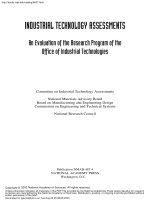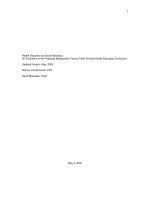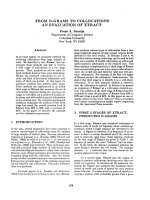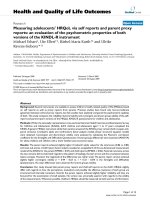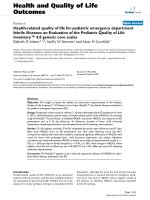an evaluation of learners attitudes towards the effectiveness of the online b1 level english learning program on website www tienganhb1 com
Bạn đang xem bản rút gọn của tài liệu. Xem và tải ngay bản đầy đủ của tài liệu tại đây (1.74 MB, 70 trang )
VIETNAM NATIONAL UNIVERSITY, HA NOI
UNIVERSITY OF LANGUAGES AND INTERNATIONAL STUDIES
FACULTY OF POST - GRADUATE STUDIES
VŨ THỊ LÊ VY
AN EVALUATION OF LEARNERS’ ATTITUDES TOWARDS
THE EFFECTIVENESS OF THE ONLINE B1 LEVEL ENGLISH
LEARNING PROGRAM ON WEBSITE WWW.TIENGANHB1.COM/
Đánh giá thái độ của học viên về tính hiệu quả của chƣơng trình
luyện thi B1 trực tuyến trên trang web www.tienganhb1.com
M.A. MINOR PROGRAMME THESIS
Field: English Teaching Methodology
Code: 60140111
Ha Noi, 2014
VIETNAM NATIONAL UNIVERSITY, HA NOI
UNIVERSITY OF LANGUAGES AND INTERNATIONAL STUDIES
FACULTY OF POST - GRADUATE STUDIES
VŨ THỊ LÊ VY
AN EVALUATION OF LEARNERS’ ATTITUDES TOWARDS
THE EFFECTIVENESS OF THE ONLINE B1 LEVEL ENGLISH
LEARNING PROGRAM ON WEBSITE WWW.TIENGANHB1.COM/
Đánh giá thái độ của học viên về tính hiệu quả của chƣơng trình
luyện thi B1 trực tuyến trên trang web www.tienganhb1.com
M.A. MINOR PROGRAMME THESIS
Field: English Teaching Methodology
Code: 60140111
Supervisor: Đỗ Tuấn Minh, Ph.D
Ha Noi, 2014
DECLARATION
I certify my authority of the study submitted entitled
AN EVALUATION OF LEARNERS’ ATTITUDES TOWARDS THE
EFFECTIVENESS OF THE ONLINE B1 LEVEL ENGLISH LEARNING
PROGRAM ON WEBSITE WWW.TIENGANHB1.COM
in fulfillment of the partial requirements for the Degree of Master of Arts at
University of Languages and International Studies, Vietnam National UniversityHanoi
Hanoi, 2014
Vũ Thị Lê Vy
i
ACKNOWLEDGEMENTS
To complete this paper, I am deeply indebted to many people for their
assistance and encouragement during the conduct of my study.
First and foremost, I would like to express my deepest thanks and gratitude
to my supervisor – Dr. Do Tuan Minh – for his continual support, enlightening
guidance, valuable advice and considerable encouragement, which are decisive
factors in the completion of this paper.
Besides, I owe a special debt of gratitude to Assoc. Prof. Le Hung Tien and
M.A Nguyen Quynh Trang for their valuable feedback on my portfolios for research
methodology subject, which guided me and laid the foundation for my study.
I deeply thank all VIP members on the website for
their enthusiasm and helpfulness in participating in my study.
My sincere thanks also go to my family and friends who gave me
unconditional support and encouragement without which my thesis would not have
been accomplished.
Last but not least, I am especially indebted to the authors whose materials
have been used in the study.
ii
ABSTRACT
The concept of online learning or e-learning has become increasingly
popular. However, studies on the evaluation of online learning still remain in
infancy, especially in Vietnam. Among the very few studies on this topic in
Vietnam, this thesis investigates the effectiveness of the online B1 level English
learning program on website (the OLP) from the
perspectives of VIP members of the website who are preparing for their B1 test in
post-graduate format. Specifically, the study seeks to measure the level of
satisfaction of the targeted participants and their suggestions for improving the
OLP. In order to achieve these aims, a model of evaluation was designed based on
the combination of Brill & Park’s (2011) and Bui Thi Thu Giang’s (2012) models.
The data were collected by means of questionnaires surveying participants’ attitudes
towards the OLP regarding the instructional design, user-friendliness, support and
cost-effectiveness; their difficulties encountered while taking the course and
suggestions for change. Interviews were conducted after that in order to obtain
insightful information concerning learners’ difficulties and recommendations.
Results show that most learners were satisfied with the design of content, level of
support provided by the website administrators and teachers and that the website is
generally user-friendly and cost-effective. Suggestions were given to improve all
four skills and all areas of instructional design, user-friendliness and level of
support. Among these, improving the design of content mostly involved adding up
new speaking topics or full B1 tests or making the OLP more motivating with
videos or supplementing translation in speaking and writing to improve
comprehensibility.
iii
TABLE OF CONTENTS
Certification of authority of the study................................................................. i
Acknowledgements ............................................................................................... ii
Abstract ................................................................................................................ iii
List of tables and abbreviations ......................................................................... vi
PART A: INTRODUCTION ................................................................................1
1. Rationale of the study......................................................................................... 1
2. Aims and research questions of the study .......................................................... 2
3. Scope of the study .............................................................................................. 2
4. Methods of the study .......................................................................................... 3
5. Significance of the study .................................................................................... 3
6. Overview of the rest of the study ....................................................................... 3
PART B: DEVELOPMENT.................................................................................5
CHAPTER 1: THEORETICAL BACKGROUND ............................................5
1.1. Introduction ..................................................................................................... 5
1.2. B1 level of English .......................................................................................... 5
1.3. Online learning ................................................................................................ 5
1.3.1. Definitions of online learning ................................................................ 5
1.3.2. Reasons for online learning ................................................................... 7
1.3.3. Challenges in online learning ................................................................ 8
1.4. Evaluation of online learning program ........................................................... 8
1.4.1. The importance of evaluation ................................................................. 8
1.4.2. Types of evaluation ................................................................................. 9
1.4.3. Models of evaluation .............................................................................. 9
1.5. Previous studies on online learning in Vietnamese context .......................... 14
1.6. Chapter summary .......................................................................................... 15
CHAPTER 2: METHODOLOGY ..................................................................... 16
2.1. Introduction ................................................................................................... 16
iv
2.2. Description of the context and participants................................................... 16
2.2.1. The context ........................................................................................... 16
2.2.2. The participants .................................................................................... 18
2.3. Data collection method ................................................................................. 19
2.3.1. Data collection instruments ................................................................. 19
2.3.2. Data collection procedure .................................................................... 21
2.4. Data analysis method and procedure ............................................................ 22
2.5. Summary ....................................................................................................... 22
CHAPTER 3: RESULTS AND DISCUSSION ................................................ 23
3.1. Introduction ................................................................................................... 23
3.2. Research question 1: To what extent are the learners satisfied with the online
B1 level English learning program on website ............. 23
3.2. Research question 2: What are the learners’ suggestions to maximize the
effectiveness of the online B1 level English learning program on website
........................................................................................ 28
3.3. Summary ....................................................................................................... 37
PART C: CONCLUSION................................................................................... 38
1. Summary of the results..................................................................................... 38
2. Limitations and suggestions for further studies ............................................... 40
BIBLIOGRAPHY ............................................................................................... 41
APPENDIX 1 ......................................................................................................... I
APPENDIX 2 ...................................................................................................... III
APPENDIX 3 ...................................................................................................... VI
APPENDIX 4 ..................................................................................................... VII
v
LIST OF TABLES
Page
Figure 1: Spectrum of evaluation perspectives
10
Figure 2: Conceptual framework applied to analysis of PBJ tutorial evaluation
13
Figure 3: Homepage of the website />
17
Figure 4: The OLP on />
17
Figure 5: The questionnaire uploaded on the website 20
Figure 6: Sample respondent’s details for the interviews
21
Table 1: Perspectives on evaluation for e-learning
11
Table 2: Criteria for the evaluation of the OLP
15
Table 3: Learner satisfaction in terms of instructional design
23
Table 4: Learner satisfaction in terms of user-friendliness
24
Table 5: Learner satisfaction in terms of support and cost-effectiveness
26
Chart 1: The importance of the OLP
27
Chart 2: Overall evaluation of the OLP
28
vi
PART A: INTRODUCTION
1. Rationale of the study
Enormous advances in information and technology and the increasing demand
for new methods of knowledge delivery have led to the rapid growth in the application
of web-based training or e-learning. Online learning is considered as “an excellent
solution for the old problem of mass education, beyond that of an impractical
apprenticeship method, since there are far too many knowledge seekers and not
enough knowledge providers” (Penalvo, 2008). Penalvo also emphasizes that elearning is possible anytime and anywhere. Additionally, online courses are at lower
costs than face to face ones (Petrova and Sinclair, as cited in Penalvo, 2008). Yang &
Yuen (2010) stress that the use of computers helps to “support teaching and learning
for educators and improve quality and excellence in education” (p. 2). Due to
numerous benefits of online learning, many educators have applied it in their teaching.
E-learning has been widespread in recent years. However, studies in the evaluation of
e-learning are still limited in number. So far very little research has dealt with elearning evaluation in Vietnam; therefore, it leaves many gaps for those who are
interested in this topic to investigate. This study aims at filling this gap.
Since the Circular No. 05 /2012/TT- BGDĐT dated 15 February, 2012 by
MOET came into effect, there has been a very high demand for learning resources to
prepare graduate learners for B1 English test. There have been several English
websites worldwide offering preparation courses for the B1 test known as PET such as
www.Tienganhb1.com. Most of these websites have guidelines for
each part of these exams including practice tests. However, none of these provide
extensive courses for B1 tests designed for Vietnamese learners, except for
www.Tienganhb1.com . The website www.Tienganhb1.com was designed and
officially launched in June, 2013 in order to meet the increasing need for B1 learning
materials in Vietnamese context. It has a wide range of online materials for B1 test in
Vietnam. Since its introduction, there have been a large number of members
1
registering for the website. Many of them applied to be VIP members with full access
to the online B1 level English learning program on website (the
OLP). However, there has been no research conducted in order to evaluate how
effective this program is to the learners. Therefore, the researcher is particularly
interested in seeking whether the program is effective to its users and there are any
suggestions to improve it.
In short, key motivation for the researcher to conduct this study is the need to
evaluate available online resources for B1 test preparation and to examine unanswered
questions left in the field.
2. Aims and research questions of the study
The first objective set out in this study is to investigate the effectiveness of the
OLP according to the level of satisfaction of VIP members, mainly using the theories
proposed by Brill & Park (2011) and Bui Thi Thu Giang (2012) as methods of
evaluation. Next, the study purports to explore learners’ suggestions to improve the
educational outcomes of the OLP.
In short, the study aims to answer the following research questions:
1.
To what extent are the learners satisfied with the online B1 level
English learning program on website />2.
of
the
What are the learners’ suggestions to maximize the effectiveness
online
B1
level
English
learning
program
on
website
/>3. Scope of the study
The study focuses on evaluating the effectiveness of the OLP from the learners’
perspectives. This is reflected by the level of users’ satisfaction with the learning
conditions referring to the instructional design, the friendliness to the users, the level
of support by teachers and administrators to the users and the course cost.
2
This work also stresses the evaluation provided by participants who are going to
take B1 test in the post graduate format as specified in the Circular No. 05 /2012/TTBGDĐT dated 15 February, 2012 by MOET. This means that participants are limited
to VIP members as MA or prospective PhD students who are going to take the B1 test
under post graduate format pursuant to the above Circular. All other VIP members
who are undergraduate students or English teachers are beyond the scope of this study.
4. Methods of the study
The study employed both qualitative and quantitative methods. The data were
gathered by using questionnaires and interviews. First, questionnaires were
administered to selected participants online after they logged into the system. Survey
questionnaires were designed based on the conceptual framework. Survey
questionnaires consisted of close-ended question to draw findings to the first questions
concerning learners’ satisfaction of the OLP and open-ended questions to capture
respondents’ difficulties encountered while taking the course and suggestions to
improve it. Next, semi-structured interviews were adopted to address the second
research question for deeper information.
5. Significance of the study
As one of the very few studies conducted on the evaluation of e-learning in
Vietnam, this research is supposed to shed some light on the field, especially on
suggesting criteria for online course evaluation as stated in the rationale. Accordingly,
the study is hoped to encourage more researchers to investigate the topic. Also, the
study is expected to explore learners’ feedbacks and suggestions for the OLP.
Therefore, with the findings of the study, the researcher wishes to propose changes to
maximize the effectiveness of the OLP.
6. Overview of the rest of the study
The rest of the study is comprised of four chapters which are as follows.
3
Chapter two, Theoretical Background, reviews prominent literature directly
relevant to the topic being discussed.
Chapter three, Methodology, presents the methods used for data collection and
data analysis as well as justification for these methods.
Chapter three is followed by chapter four, Results and Discussion, in which the
findings of the study are discussed to answer the research questions.
Finally in chapter five, recapitulation of the whole study is presented before
suggestions for further studies and a conclusion are given.
4
PART B: DEVELOPMENT
CHAPTER 1: THEORETICAL BACKGROUND
1.1. Introduction
This chapter provides definitions and background of the theories and concepts
related to the topic investigated in this research paper. Specifically, the researcher will
discuss the concepts of B1 level of English, online learning and evaluation of an online
learning program.
1.2. B1 level of English
B1 level of English varies in definitions. B1 is equivalent to level 3/6 of
Common European Framework of Reference for Languages (CEFR). Like other tests
in CEFR, B1 equivalent to PET is organized worldwide by Cambridge English
language assessment, Cambridge University. In Vietnam, B1 is obligatory for nonEnglish major students at graduation, MA students before thesis defense or prospective
PhD students. Therefore, the researcher would like to clarify this concept in this study.
B1 level of English in this research means the one in post-graduate format, certified in
the Circular No. 05 /2012/TT- BGDĐT dated 15 February, 2012 by MOET for those
who are completing MA courses or submitting doctorate proposals (seen in the
Appendix 4).
1.3. Online learning
1.3.1. Definitions of online learning
“Online learning” is defined as the application of Web-based tools for learning
purposes (Penalvo, 2008). Other synonymous terms could be virtual learning, distance
learning or e-learning. The following definition of online learning is provided by
Petrova and Sinclair (as cited in Penalvo, 2008):
5
E-learning is used as a comprehensive term to identify the use of a variety of
information and communication technologies to enhance and support learning, often
blending their use. Online learning can be defined as an implementation of e-learning using
Web-based technologies (Petrova, 2007).
Petrova and Sinclair (as cited in Penalvo, 2008, p. 113)
Online learning can also be referred to as computer-assisted language learning
(CALL). Ken Beatty (2010) gives a broad definition of CALL as “any process in
which a learner uses a computer, and as a result, improves his or her language”. It
covers a range of activities known as a reward for better learners or a remedial aid for
weaker students. Materials may comprise purpose-made ones for language learning or
those which are adapted from existing computer-based materials, videos. Delivery
methods might involve online instruction through the WWW, distance and networked
learning using emails, blogs, online social networking and other interactive sites and
services (Beatty, 2010).
Horton (2011) shares the similar definition of e learning with Penalvo (2008)
and Beatty (2010) as “the use of electronic technologies to create learning
experiences”. Several types of e-learning are standalone courses, learning games and
simulations, mobile learning, social learning, virtual classroom courses, the first of
which are courses taken by individual learners without interaction with teachers and
classmates.
According to Bakia et al. (2012), “online learning” refers to the Internet-based
instructional environment in which instructions are delivered to students through the
Internet or interactions are facilitated between teachers and students and among
students in some cases. “Online learning” can be either fully online or blended
learning. The former is considered as a form of distance education with all instruction
and assessment carried out online. The latter refers to a combination of traditional
face-to-face interactions and instructions through the Internet.
6
In short, a variety of terms are used to define online learning, for example, elearning, virtual learning, distance learning, web-based learning, and computerassisted language learning. All of these terms share the same meaning, so they will be
used interchangeably in this research. In this study, online learning includes a range of
activities classified into four skills uploaded on the website or web-based activities
allowing learners to practice. Online learning program is a fully online or standalone
course taken by individuals without interaction among classmates.
1.3.2. Reasons for online learning
With the increasing popularity of the Internet, online learning has many
advantages.
Firstly, it is flexible. It is true that for e-learning, users can access whenever and
wherever they like. As a result, geographical location is not an issue. It might be
difficult to have meetings in different time zones (Hockly & Clandfield , 2010, p. 10).
Bakia et al. (2012) also emphasizes that the popularity of online learning is caused by
more flexible access and instruction. It helps to increase the learning experiences for
those unable to attend face-to-face lessons.
Secondly, online courses are more cost-saving than traditional lessons. (Hockly
& Clandfield , 2010) also consider e-learning courses to be cheap for learners.
Accordingly, the ratios of students and teachers are raised but learning outcomes
remain equal to those of traditional classroom instruction.
Finally, online learning provides a more efficient dissemination of instructional
content. Thanks to the use of multimedia, learners tend to be more interested and
motivated (Ravichandran, 2000, p. 82 as cited in Mariott & Torres, 2009). Also, the
use of Internet caters for learners’ different styles of learning.
7
1.3.3. Challenges in online learning
Although benefits of online learning are numerous, its drawbacks are
unavoidable. Web-based learning provides learners with flexibility but learners have to
be self-disciplined and self-motivated. Loading speed is another problem when lowerbandwidth may cause difficulty in viewing some multimedia. Some learners may find
working online alienating, or spend too much time already online at work.
The literature of online learning so far has addressed the following concerns:
the quality of e-learning with learning outcomes, student persistence and student
satisfaction. There are controversies over the quality of e-learning. Some studies state
that there are no differences between the learning outcomes of traditional classrooms
and e-learning (Russell, 1999; Tran Thanh Dien & Esichaikul, 2007). Another
challenge is student persistence in online learning with high dropout rates. Feelings of
anxiety, isolation and confusion are blamed for dropout rates among students (King,
2002).
1.4. Evaluation of online learning program
1.4.1. The importance of evaluation
Evaluation refers to “assigning a value to something” (Horton, 2001, p. 1). It
gives the answers to the questions about the value of an e-learning course or project.
Horton also emphasizes that only evaluation can measure the success of a firm.
Horton (2001) gives some particular reasons for an evaluation of e-learning as follows:
- Justify investments in training
- Make better decisions about training
- Hold participants accountable
- Demonstrate financial responsibility
- Improve training quality
8
- Encourage learning
Various aspects of training can be measured in terms of quality and
effectiveness through evaluation such as materials, instructors, facilities, and
presentation techniques. Horton (2001) stresses that a good evaluation process should
be flexible, reliable, economical and easy to implement.
Brill & Park (2011) also emphasizes that “evaluation plays an essential role in
almost all instructional development (ID) models and training cycles”.
In fact,
evaluation is central to the quality of training courses. Another reason for evaluation
lies in the decision making process toward the effectiveness and cost-effectiveness of
learning sources. Evaluation for development purpose has now been more popular than
judgmental purpose.
The evaluation of the OLP in this study was conducted to enhance the quality of
the OLP so that learning is more motivational and promoted.
1.4.2. Types of evaluation
There are two types of evaluation: formative and summative evaluation. The
former focuses information on program improvement. The latter, on the other hand,
uses information to make decisions among options or to certify the effectiveness of a
program. Most evaluations are both formative and summative (Baker & Alkin, 1973;
Scriven, 1967 as cited in Yang & Yuen, 2000).
The evaluation of the OLP on the
researched website adopted both of them. The outcomes of the evaluation are expected
to make changes to the existing system for the better. At the same time, judgments are
made towards the effectiveness of the program.
1.4.3. Models of evaluation
Horton (2001) claims evaluation should start with the scope of evaluation from
micro to macro breadth of view. The micro view concerns with specific results of a
particular learning objective whereas the macro one deals with broader results.
9
Figure 1: Spectrum of evaluation perspectives
He suggests that evaluators should consider the scope of evaluation, the
economic role in e-learning, timing, internal or external evaluation, the results
achieved once the evaluation finishes.
10
Perspective
Postitions for
Why evaluate
Your evaluation
From this position?
Breadth of View
□ Component or course
At what scope – micro or
□ Specific courses
macro – do you evaluate?
□ Whole curriculum
□ Particular company
□ Particular industry
□ Society as a whole
Economic role
Producer
What are your economic
□ Designer
roles in e-learning?
□ Builder
□ Seller
□Distributor
Consumer
□ Purchaser
□ Learner
Timing
□ Before training is developed
When do you conduct
□ For an existing training
evaluations?
package
□ After training has been
conducted
Internal versus External
□ Internal development and
What characteristics do you
management processes
evaluate?
□ External results experienced
by customers
Levels
□ Level 1: Response
What levels of outcomes do
□ Level 2: Learning
you evaluate?
□ Level 3: Performance
□ Level 4: Business results
Table 1: Perspectives on evaluation for e-learning (Horton, 2001, p. 11)
11
Son (2005) on evaluating websites uses a likert scale to evaluate the selected
websites in terms of the purpose, the accuracy of the content, currency or updating of
the website, authority, loading speed, usefulness, organization, navigation, reliability,
authenticity, interactivity, feedback, multimedia, communication, integration.
Torstein Rekkedal (2006) mentions criteria for evaluating the quality of elearning programs including the credibility of the institution delivering the online
course, the quality assurance or quality management system, pre-enrolment
information and guidance on whether or not information is provided sufficiently for
learners to decide to take the course, course costs, subject-related, social and technical
support for e-learners, individual preferences (whether the e-learning course cater for
learners’ needs in terms of structure, communication and learning styles) .
Hadjerrouit (2010) suggests usability as a criterion for evaluation. Usability
comprises technical usability and pedagogical usability. The former concerns
evaluating content design, page design and site design. The latter deals with
assessment of understandability, added value, goal-orientation, time, interactivity,
multimedia, motivation, differentiation, flexibility, autonomy, collaboration, variation.
Brill & Park (2011) applied a model of evaluation including three elements,
namely the characteristics of the evaluand, the dimensions of evaluation, and the
application of results.
12
Figure 2: Conceptual framework applied to analysis of PBJ tutorial evaluation
(Brill & Park, 2011)
Concerning the dimensions of evaluation, Brill & Park (2011) created their
framework of three levels (reaction, learning, and transfer) in light of Kirkpatrick’s
model. Criteria comprise evaluating learning conditions concerning design of content
and user-friendliness and evaluating learning.
It can be seen that there has been no consensus in the literature regarding
criteria for evaluating an online course. Among these, however, the model of Brill and
Park (2011) seems to be the most comprehensible with clear criteria and guidelines for
evaluation.
13
1.5. Previous studies on online learning in Vietnamese context
As has been mentioned, very few studies have been done on evaluating an
online program in Vietnamese context. One notable work attempting to deal with this
phenomenon exhaustively is that by Bui Thi Thu Giang (2012) on the effectiveness of
the online learning program blended with the traditional course to second-year nonEnglish major students at Hanoi University of Industry. By using such methods as
survey questionnaires, interviews, pretests and posttests and online learning reports,
she found that both students and teachers appreciated the online learning program.
Also, the learning reports and the findings from pretests and posttests showed that the
online learning program is effective to the students.
The other on evaluating an online program conducted in Vietnam that the
researcher could find is the “Effective evaluation of online learning environment: a
case study of Can Tho University” by Tran Thanh Dien & Esichaikul (2007). The
researchers used questionnaires to students and instructors and hypothesis testing. By
conducting this study, they wanted to compare traditional (face-to-face) and online
learning program and the statistics showed that there is a difference in students’
learning achievements. However, the comparative evaluation is not even because the
results were measured on the same learners on two different subjects. Moreover, the
research is a case study; therefore, the results cannot be generalized to a larger
population.
In short, except for the work by Bui Thi Thu Giang (2012) that holds major
significance in laying the theoretical foundation for other studies on evaluating an
online program in Vietnamese context, papers on this topic in Vietnam have been very
limited in number. This reality, as clarified in the introduction, has constituted a good
reason for the conduct of this study.
14
1.6. Chapter summary
So far this chapter has reviewed existing literature relevant to the topic in
question. General definitions of key concepts have been presented, followed by types
of e-learning evaluation and models of evaluation. It can be concluded from the
review of literature that little consensus is reached when it comes to the issues related
to phenomenon of e-learning evaluation. However, having examined and evaluated
different proposed theories, the researcher has decided to mainly take Brill & Park’s
(2011) and Bui Thi Thu Giang’s (2012) suggested model for evaluation as theoretical
framework for this study because of their intelligibility to readers and its
comprehensive coverage.
In short, following criteria will be applied in evaluating the OLP in this study.
Instructional Objectives
design
Content
Do the objectives of the OLP meet learners’ goals?
- Is the content of the OLP relevant to learners’
needs?
- Are the instructions clear and easy to understand?
Practice
feedback
User
friendliness
Others
& Do learners have opportunity to practice and get
feedback for their practice?
Accessibility
Is it easy to access the OLP?
Navigation
& Control
Is it easy to locate the skills and knowledge needed
practising?
Media
Is the multimedia useful in conveying the content?
Delivery
method
Is the content presented in an understandable way to
learners?
Support
Do learners receive enough academic and technical
support?
Costeffectiveness
Is the cost of the course in accordance with expected
results and benefits for the learners?
Table 2: Criteria for the evaluation of the OLP
In the next chapter, details on how this study was conducted will be presented.
15
CHAPTER 2: METHODOLOGY
2.1. Introduction
This chapter gives an overall account of the participants from which the data
were drawn, and presents the methods of data collection and data analysis.
This chapter consists of three sections. In the first section, a general description
of the context and participants is given. The second section presents the methods of
gathering data and the rationale for adopting these data collection methods, followed
by procedure of data collection. Finally, data analysis methods will be described.
2.2. Description of the context and participants
2.2.1. The context
www.TiengAnhB1.com comprises B1 test related information, for example, a
full description of B1 test for graduate students and a comparison of this and other
types of B1 tests, authorized institutions organizing this kind of test and most
importantly, an online learning program. The test preparation program consists of tests
at all four skills Listening, Speaking, Reading and Writing categorized according to
the post-graduate format specified in the Circular No. 05 /2012/TT- BGDĐT dated 15
February, 2012 by MOET (seen in the Appendix 4) required for graduate students
before thesis defense and doctorate dissertation submission. Materials are mostly
compiled from PET resources such as past examinations by Cambridge University
Press and other books preparing students for the test. Besides, test-like items with
sample answers are provided for speaking part following topics regulated by the
MOET. For Listening and Reading including mostly multiple choice items, learners
take the test online and check answers. Listening is provided with transcripts to
facilitate low-level learners to check their answers. The content of the online program
is constantly updated thanks to the release of new books or continuous research of
recent exams organized by authorized institutions.
16
Figure 3: Homepage of the website />
Figure 4: The OLP on />
17

